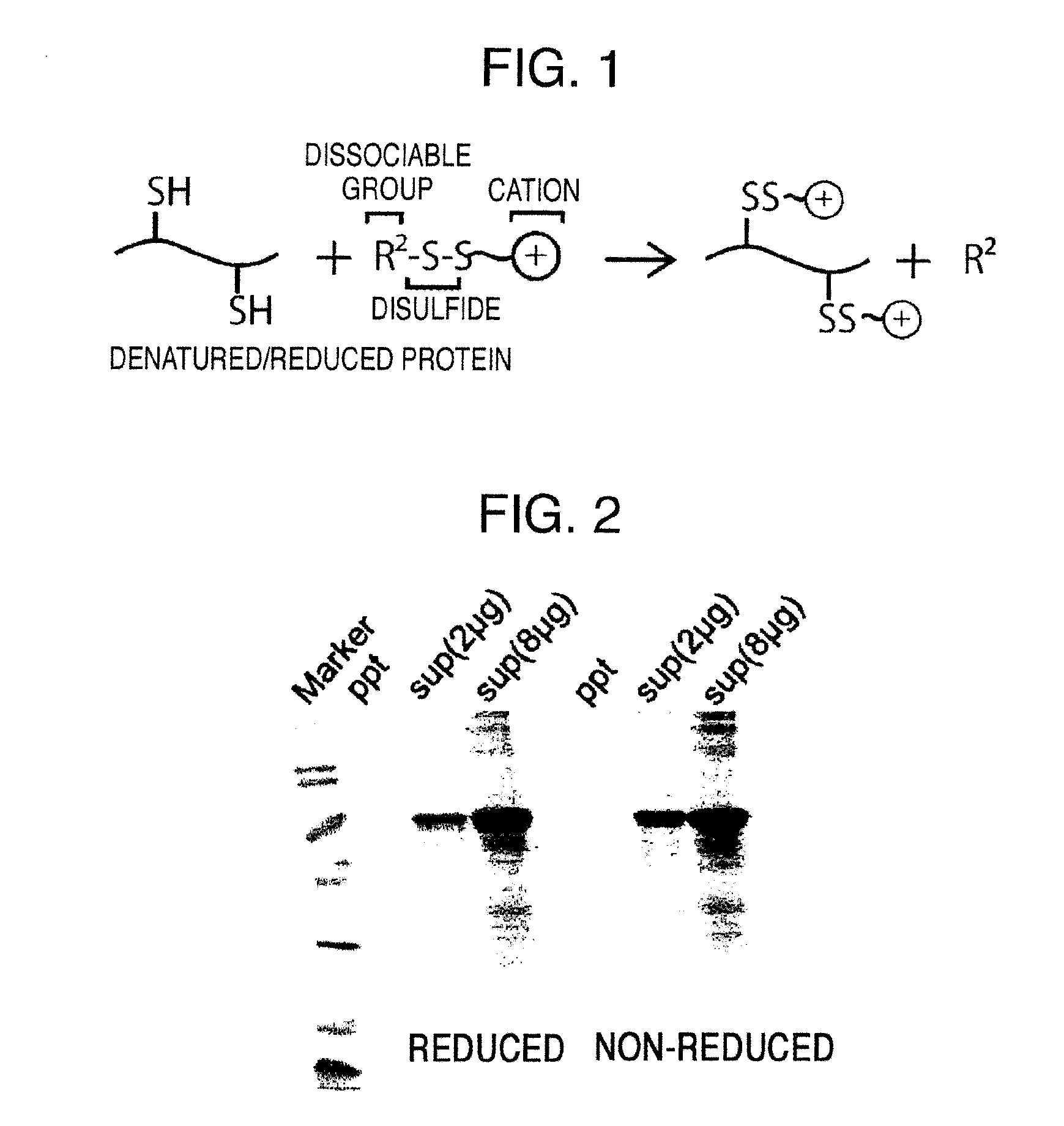Method for producing reagent for antibody detection and use thereof
a technology for producing reagents and antibodies, applied in the direction of tumor rejection antigen precursors, instruments, peptide sources, etc., can solve the problems of antibody binding, no attempt has been made so far on the process of preparing reagents for antibody detection, and it is difficult to provide seamless epitope peptides, etc., to achieve efficient production methods, inhibit time-dependent generation, and solubilize and recover antigenic proteins
- Summary
- Abstract
- Description
- Claims
- Application Information
AI Technical Summary
Benefits of technology
Problems solved by technology
Method used
Image
Examples
example 1
[0115]Hereinafter, the present invention will be described in detail with reference to Examples. However, the present invention is not intended to be limited by these Examples by any means, as a matter of course.
[0116]First, each antigenic protein for use in antibody detection was prepared.
[0117]E. coli T7 Express was transformed with each of 2 types of plasmid DNAs of His-tag-fused MAGE-A4 (SEQ ID NOs: 16 and 17, antigenic protein sequence: SEQ ID NOs: 3 and 4) and His-tag-fused WT-1 (SEQ ID NOs: 14 and 15, antigenic protein sequence: SEQ ID NOs: 1 and 2) cloned into pET28b vectors. Several colonies formed on a plate were picked up, then added to 10 mL of an LB / Kan25 medium, and shake-cultured for 2 hours.
[0118]Next, a small amount of the cultures was added to 400 mL of a TB medium and further cultured at 37° C. When the bacterial cell concentration reached OD600=0.7 to 0.8, IPTG was added thereto at a final concentration of 0.5 mM. The cells were further cultured at 37° C. for 3 h...
example 2
Analysis of Antibody Contained in Serum of Cancer Patient—1
[0151]Blood was collected from two cancer patients (Donor 1 and Donor 2), and serum was obtained therefrom.
[0152]Six types of magnetic beads on which the antigenic proteins (NY-ESO-1, WT-1, MAGE-A4, XAGE1b, gp100, and Survivin-2B) were respectively immobilized were mixed at the same concentrations and dispensed to the wells of a 96-well plate (Bio-Rad Laboratories, Inc., #171-025001). The serum of each patient was added to each well. While shielded from light using an aluminum foil, the plate was shaken at room temperature for 1 hour for reaction. The beads were washed with Wash Station (Bio-Rad Laboratories, Inc.). For antibody detection, biotinylated anti-human IgG (H+L) (manufactured by Vector Laboratories, Inc., BA-3000) was added as a secondary antibody to each well. While shielded from light using an aluminum foil, the plate was shaken at room temperature for 30 minutes for reaction. The beads were washed with Wash Sta...
example 3
Analysis of Antibody Contained in Serum of Cancer Patient—2
[0157]Serum was obtained from 8 renal cell cancer patients (Donor 2 to Donor 9) before and after EP-DC therapy.
[0158]The EP-DC therapy refers to a treatment method which involves: preparing lysates by the freeze-thaw method or the like from tumor tissues removed by surgery from a cancer patient; electroloading the lysates into dendritic cells; and administering the dendritic cell vaccine thus prepared to the patient.
[0159]Six types of magnetic beads on which the antigenic proteins were respectively immobilized were mixed at the same concentrations and dispensed to the wells of a 96-well plate (Bio-Rad Laboratories, Inc., #171-025001). The serum of each patient was added to each well. While shielded from light using an aluminum foil, the plate was shaken at room temperature for 1 hour for reaction. The beads were washed with Wash Station (Bio-Rad Laboratories, Inc.). For antibody detection, biotinylated anti-human IgG (H+L) (...
PUM
| Property | Measurement | Unit |
|---|---|---|
| temperature | aaaaa | aaaaa |
| temperature | aaaaa | aaaaa |
| time | aaaaa | aaaaa |
Abstract
Description
Claims
Application Information
 Login to View More
Login to View More - R&D
- Intellectual Property
- Life Sciences
- Materials
- Tech Scout
- Unparalleled Data Quality
- Higher Quality Content
- 60% Fewer Hallucinations
Browse by: Latest US Patents, China's latest patents, Technical Efficacy Thesaurus, Application Domain, Technology Topic, Popular Technical Reports.
© 2025 PatSnap. All rights reserved.Legal|Privacy policy|Modern Slavery Act Transparency Statement|Sitemap|About US| Contact US: help@patsnap.com



